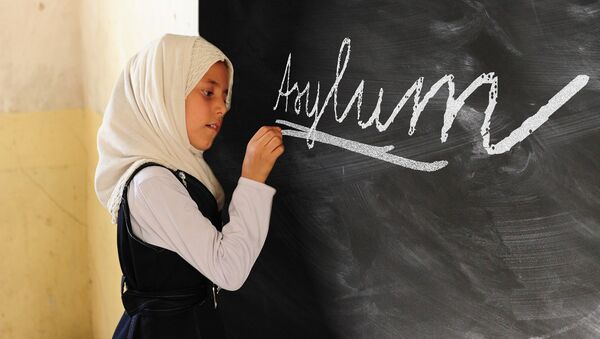With a population of approximately 63,000, most of its inhabitants are Sicilian, or Nisseni, as they are known locally. Most of the languages encountered in the town are either Italian, or the local Sicilian dialect.
Caltanissetta valley — central Sicily pic.twitter.com/3V04KbfStH
— ILoveItaly (@I__Love__Italy) May 20, 2016
What distinguishes Caltanissetta from other Italian towns is not only its unique beauty, but also that over the past few years it has acted as a thoroughfare for refugees fleeing war and poverty in the Middle East and North Africa.
"Caltanissetta's people have been very welcoming and hospitable to us. I never thought I would end up in the mountains of Italy, but somehow I'm here, and I'm thankful," Sama Ahmad, an Afghan refugee hoping to be granted asylum in Germany, told Sputnik, with a sense of joy in her voice.
Around 34,000 migrants and asylum seekers have arrived Italy in 2016, most of them via the Straight of Sicily.
Latest migrant landing in Sicily some 200 people rescued near Libya #refugees pic.twitter.com/ciHXiNpMw2
— simona (@SimonaSkm) May 24, 2016
Save the Children in Sicily saying they’ve had more than 5,000 unaccompanied minors arrive already this year out of 32,500 total #refugees
— simona (@SimonaSkm) May 23, 2016
Caltanissetta caught the international communities attention this month after it was revealed that a group of refugees, mainly Syrians rescued from Sicily's coast, have been providing English lessons to the local police force.
"We decided that we are here for now, and while we are, we might as well give something back to a community that has been mostly welcoming," said Bader Mamlouk, a Syrian refugee who fled when his town was overrun by Sunni extremists.
After being rescued at sea, most refugees are transported by the Italian Navy to asylum reception centers scattered along the coast, where they undergo vetting and identification. After this, they are moved on to centres called 'Sprars', which are usually located inland. The problem refugees face is that sometimes they wait weeks, or in extreme cases years, before getting their paperwork to live legally in Europe.
Police Chief Diego Peruga said that he and the mayor decided to set up the English crash courses after local police officers said that basic English skills would make their jobs easier.
Caltanissetta is a popular tourist destination for holidaymakers from around Europe who often cannot speak Italian and regularly use English to communicate with the locals.
"It was a shame to see so many of the refugees sitting around not doing much while waiting to be granted asylum. We thought it would be a good opportunity for them to teach us something, and for us to learn from them," Peruga told Sputnik.
The lessons currently consist of around 30 hours, and involve bi-weekly crash courses for 74 members of the local police force. Caltanissetta mayor, Giovanni Ruvolo, told Italian newspaper The Local that "behind news stories of statistics and tragedies there are unique and talented people".
Stories of a similar nature have emerged in other parts of Europe. Last year a story emerged in the UK about a group of Syrian refugees who helped to build a flood defence in Manchester.
One of the refugees, Yasser al-Jassem, said that "the people of Manchester have been very good to us, so we wanted to offer our help to them".
Much of the coverage on refugees focuses on those who disappear when making the perilous journey across the Mediterranean. Unfortunately, little attention is given to what happens after many arrive in Europe. Stories like the one coming out of Caltanissetta show that many refugees simply wish to find a new home.



